Management and Leadership Roles at Starbucks: A Comprehensive Analysis
VerifiedAdded on 2020/10/05
|14
|4589
|116
Report
AI Summary
This report provides a detailed analysis of leadership and management within Starbucks' UK operations. It begins by defining and comparing the roles and characteristics of leaders and managers, highlighting the key differences in their approaches, aims, and skills. The report then examines how these roles apply in various contexts, such as technological advancements, conflict resolution, and fluctuating raw material costs, using functional examples from Starbucks. Different leadership theories and models, including situational and system leadership, are explored. The report further investigates key approaches to operations management and the significance of operations management in achieving business objectives. Finally, it assesses the factors within the business environment that impact operational management and decision-making. The analysis covers leadership styles, management functions, and the application of these concepts within the competitive landscape of the food industry.
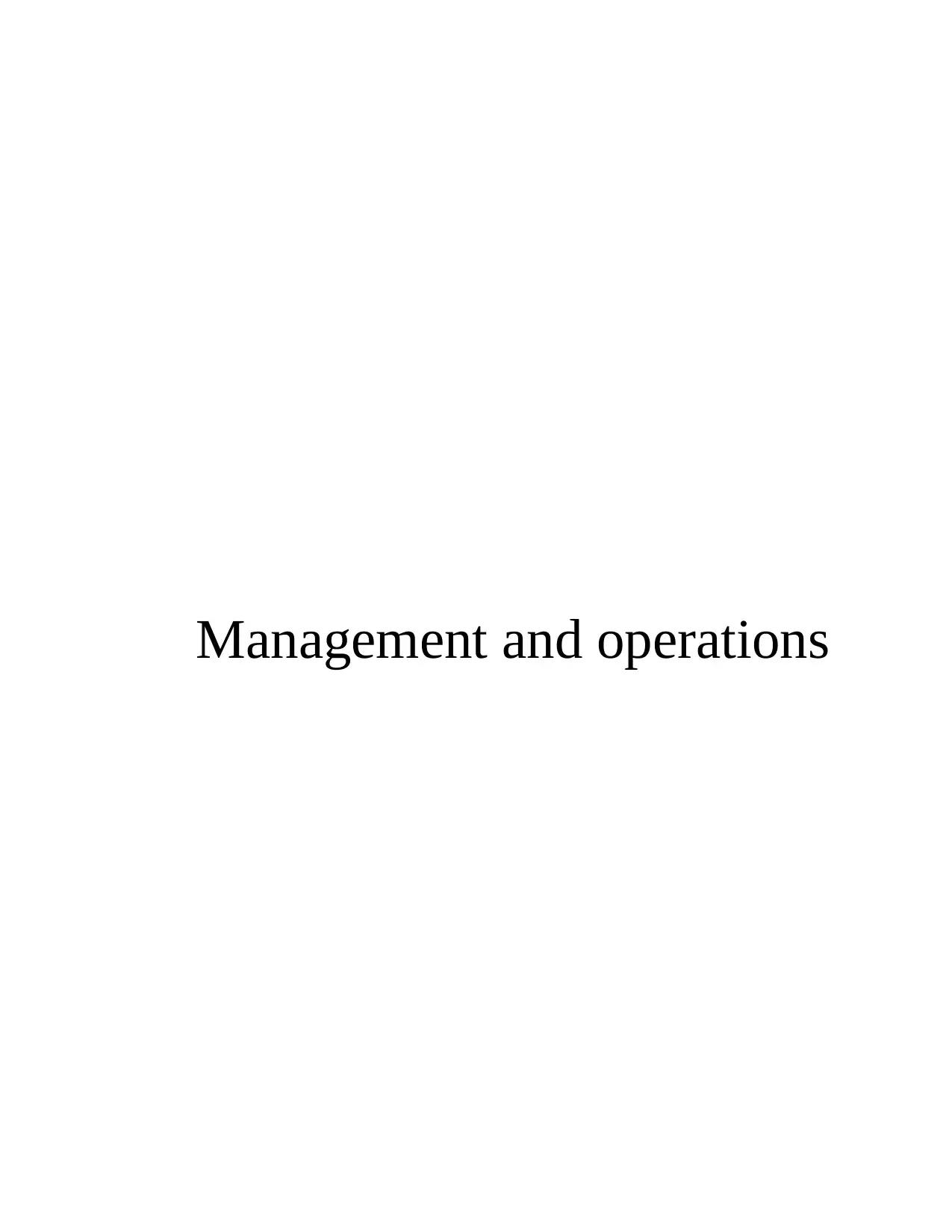
Management and operations
Paraphrase This Document
Need a fresh take? Get an instant paraphrase of this document with our AI Paraphraser
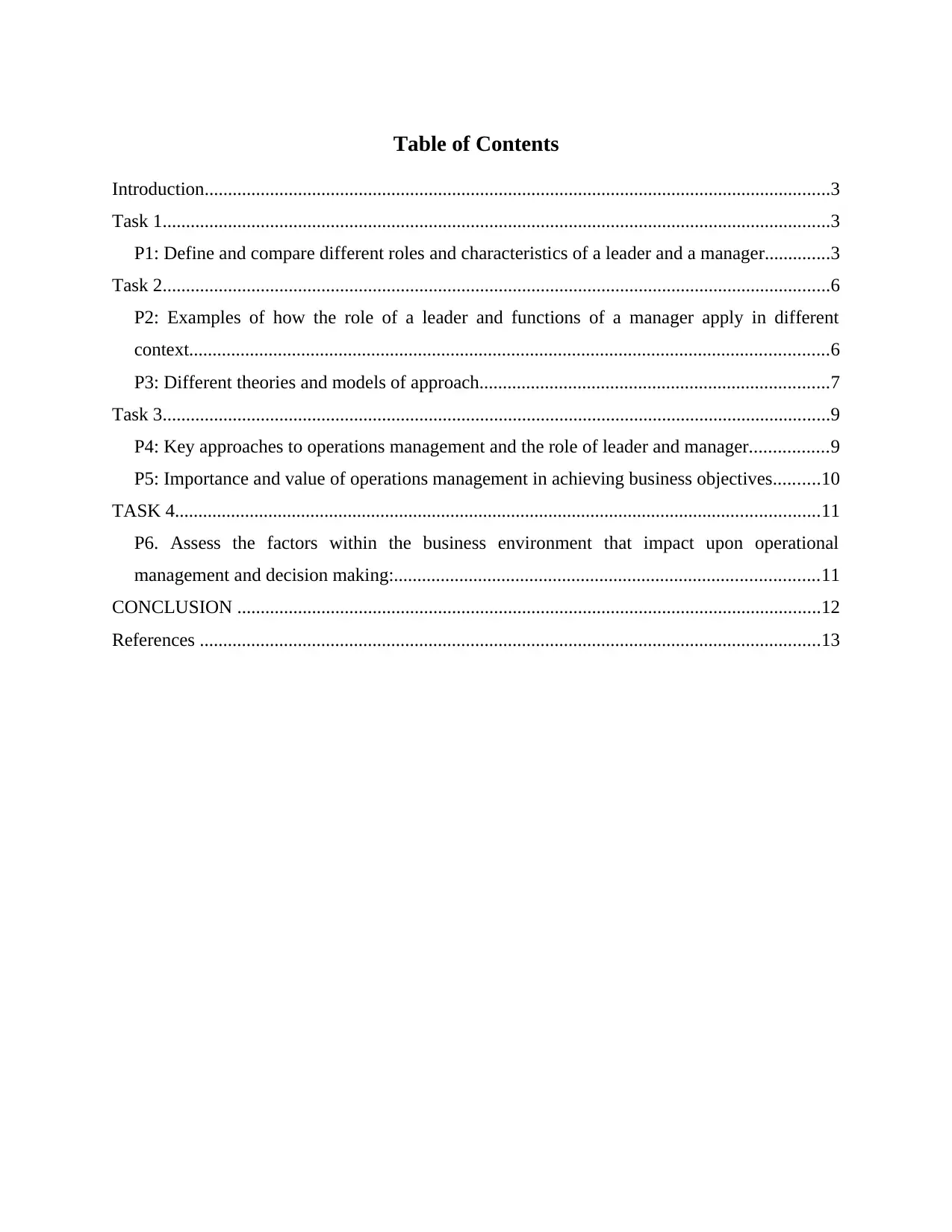
Table of Contents
Introduction......................................................................................................................................3
Task 1...............................................................................................................................................3
P1: Define and compare different roles and characteristics of a leader and a manager..............3
Task 2...............................................................................................................................................6
P2: Examples of how the role of a leader and functions of a manager apply in different
context.........................................................................................................................................6
P3: Different theories and models of approach...........................................................................7
Task 3...............................................................................................................................................9
P4: Key approaches to operations management and the role of leader and manager.................9
P5: Importance and value of operations management in achieving business objectives..........10
TASK 4..........................................................................................................................................11
P6. Assess the factors within the business environment that impact upon operational
management and decision making:...........................................................................................11
CONCLUSION .............................................................................................................................12
References .....................................................................................................................................13
Introduction......................................................................................................................................3
Task 1...............................................................................................................................................3
P1: Define and compare different roles and characteristics of a leader and a manager..............3
Task 2...............................................................................................................................................6
P2: Examples of how the role of a leader and functions of a manager apply in different
context.........................................................................................................................................6
P3: Different theories and models of approach...........................................................................7
Task 3...............................................................................................................................................9
P4: Key approaches to operations management and the role of leader and manager.................9
P5: Importance and value of operations management in achieving business objectives..........10
TASK 4..........................................................................................................................................11
P6. Assess the factors within the business environment that impact upon operational
management and decision making:...........................................................................................11
CONCLUSION .............................................................................................................................12
References .....................................................................................................................................13
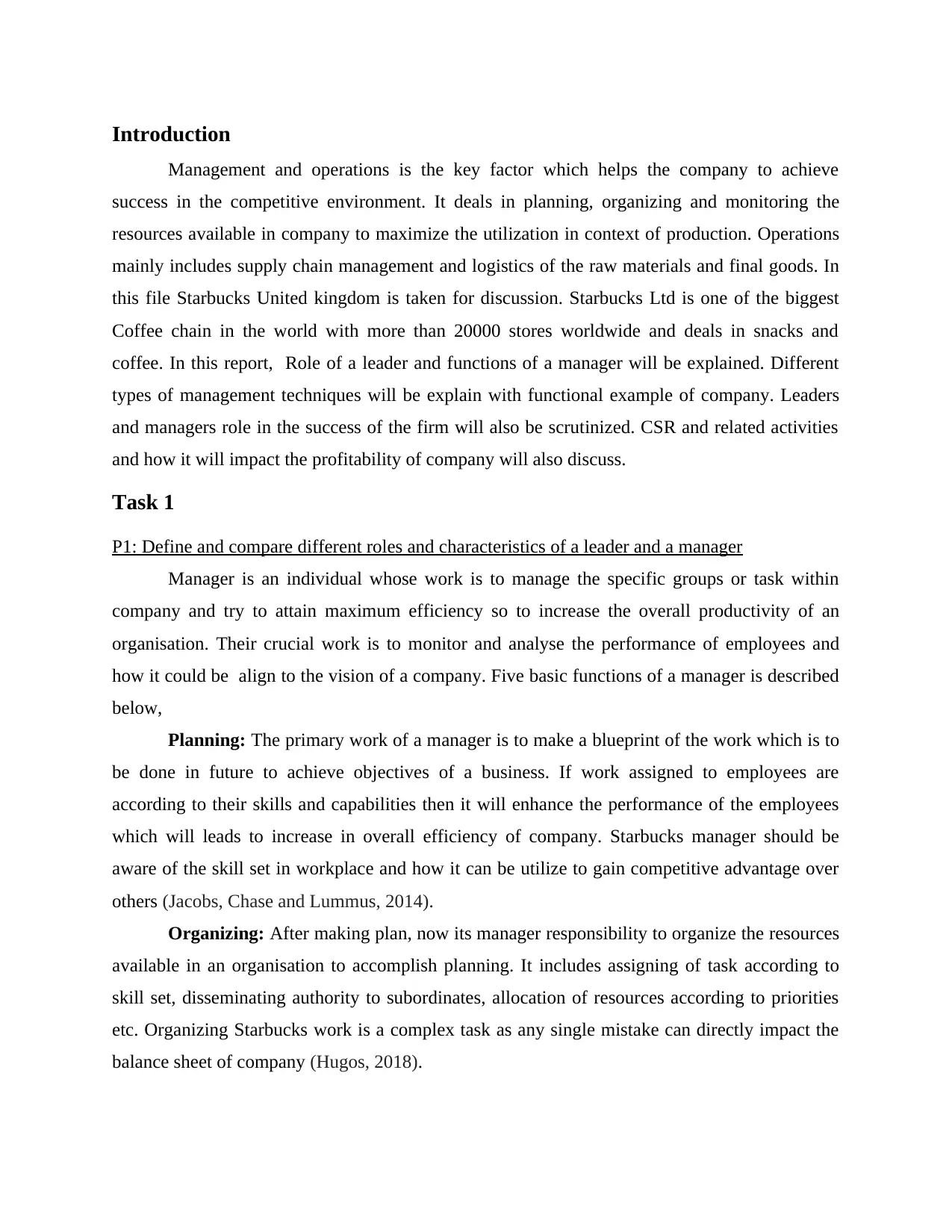
Introduction
Management and operations is the key factor which helps the company to achieve
success in the competitive environment. It deals in planning, organizing and monitoring the
resources available in company to maximize the utilization in context of production. Operations
mainly includes supply chain management and logistics of the raw materials and final goods. In
this file Starbucks United kingdom is taken for discussion. Starbucks Ltd is one of the biggest
Coffee chain in the world with more than 20000 stores worldwide and deals in snacks and
coffee. In this report, Role of a leader and functions of a manager will be explained. Different
types of management techniques will be explain with functional example of company. Leaders
and managers role in the success of the firm will also be scrutinized. CSR and related activities
and how it will impact the profitability of company will also discuss.
Task 1
P1: Define and compare different roles and characteristics of a leader and a manager
Manager is an individual whose work is to manage the specific groups or task within
company and try to attain maximum efficiency so to increase the overall productivity of an
organisation. Their crucial work is to monitor and analyse the performance of employees and
how it could be align to the vision of a company. Five basic functions of a manager is described
below,
Planning: The primary work of a manager is to make a blueprint of the work which is to
be done in future to achieve objectives of a business. If work assigned to employees are
according to their skills and capabilities then it will enhance the performance of the employees
which will leads to increase in overall efficiency of company. Starbucks manager should be
aware of the skill set in workplace and how it can be utilize to gain competitive advantage over
others (Jacobs, Chase and Lummus, 2014).
Organizing: After making plan, now its manager responsibility to organize the resources
available in an organisation to accomplish planning. It includes assigning of task according to
skill set, disseminating authority to subordinates, allocation of resources according to priorities
etc. Organizing Starbucks work is a complex task as any single mistake can directly impact the
balance sheet of company (Hugos, 2018).
Management and operations is the key factor which helps the company to achieve
success in the competitive environment. It deals in planning, organizing and monitoring the
resources available in company to maximize the utilization in context of production. Operations
mainly includes supply chain management and logistics of the raw materials and final goods. In
this file Starbucks United kingdom is taken for discussion. Starbucks Ltd is one of the biggest
Coffee chain in the world with more than 20000 stores worldwide and deals in snacks and
coffee. In this report, Role of a leader and functions of a manager will be explained. Different
types of management techniques will be explain with functional example of company. Leaders
and managers role in the success of the firm will also be scrutinized. CSR and related activities
and how it will impact the profitability of company will also discuss.
Task 1
P1: Define and compare different roles and characteristics of a leader and a manager
Manager is an individual whose work is to manage the specific groups or task within
company and try to attain maximum efficiency so to increase the overall productivity of an
organisation. Their crucial work is to monitor and analyse the performance of employees and
how it could be align to the vision of a company. Five basic functions of a manager is described
below,
Planning: The primary work of a manager is to make a blueprint of the work which is to
be done in future to achieve objectives of a business. If work assigned to employees are
according to their skills and capabilities then it will enhance the performance of the employees
which will leads to increase in overall efficiency of company. Starbucks manager should be
aware of the skill set in workplace and how it can be utilize to gain competitive advantage over
others (Jacobs, Chase and Lummus, 2014).
Organizing: After making plan, now its manager responsibility to organize the resources
available in an organisation to accomplish planning. It includes assigning of task according to
skill set, disseminating authority to subordinates, allocation of resources according to priorities
etc. Organizing Starbucks work is a complex task as any single mistake can directly impact the
balance sheet of company (Hugos, 2018).
⊘ This is a preview!⊘
Do you want full access?
Subscribe today to unlock all pages.

Trusted by 1+ million students worldwide
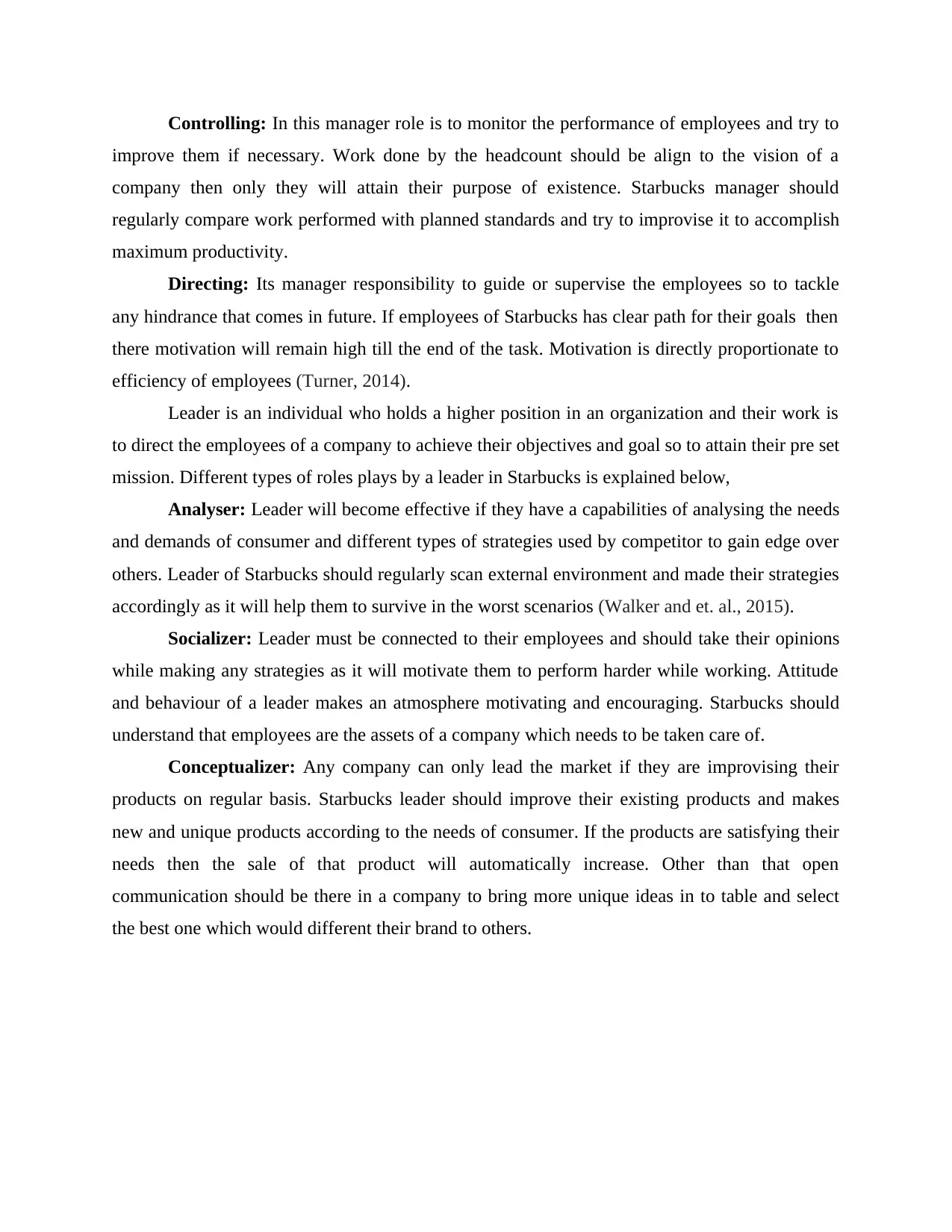
Controlling: In this manager role is to monitor the performance of employees and try to
improve them if necessary. Work done by the headcount should be align to the vision of a
company then only they will attain their purpose of existence. Starbucks manager should
regularly compare work performed with planned standards and try to improvise it to accomplish
maximum productivity.
Directing: Its manager responsibility to guide or supervise the employees so to tackle
any hindrance that comes in future. If employees of Starbucks has clear path for their goals then
there motivation will remain high till the end of the task. Motivation is directly proportionate to
efficiency of employees (Turner, 2014).
Leader is an individual who holds a higher position in an organization and their work is
to direct the employees of a company to achieve their objectives and goal so to attain their pre set
mission. Different types of roles plays by a leader in Starbucks is explained below,
Analyser: Leader will become effective if they have a capabilities of analysing the needs
and demands of consumer and different types of strategies used by competitor to gain edge over
others. Leader of Starbucks should regularly scan external environment and made their strategies
accordingly as it will help them to survive in the worst scenarios (Walker and et. al., 2015).
Socializer: Leader must be connected to their employees and should take their opinions
while making any strategies as it will motivate them to perform harder while working. Attitude
and behaviour of a leader makes an atmosphere motivating and encouraging. Starbucks should
understand that employees are the assets of a company which needs to be taken care of.
Conceptualizer: Any company can only lead the market if they are improvising their
products on regular basis. Starbucks leader should improve their existing products and makes
new and unique products according to the needs of consumer. If the products are satisfying their
needs then the sale of that product will automatically increase. Other than that open
communication should be there in a company to bring more unique ideas in to table and select
the best one which would different their brand to others.
improve them if necessary. Work done by the headcount should be align to the vision of a
company then only they will attain their purpose of existence. Starbucks manager should
regularly compare work performed with planned standards and try to improvise it to accomplish
maximum productivity.
Directing: Its manager responsibility to guide or supervise the employees so to tackle
any hindrance that comes in future. If employees of Starbucks has clear path for their goals then
there motivation will remain high till the end of the task. Motivation is directly proportionate to
efficiency of employees (Turner, 2014).
Leader is an individual who holds a higher position in an organization and their work is
to direct the employees of a company to achieve their objectives and goal so to attain their pre set
mission. Different types of roles plays by a leader in Starbucks is explained below,
Analyser: Leader will become effective if they have a capabilities of analysing the needs
and demands of consumer and different types of strategies used by competitor to gain edge over
others. Leader of Starbucks should regularly scan external environment and made their strategies
accordingly as it will help them to survive in the worst scenarios (Walker and et. al., 2015).
Socializer: Leader must be connected to their employees and should take their opinions
while making any strategies as it will motivate them to perform harder while working. Attitude
and behaviour of a leader makes an atmosphere motivating and encouraging. Starbucks should
understand that employees are the assets of a company which needs to be taken care of.
Conceptualizer: Any company can only lead the market if they are improvising their
products on regular basis. Starbucks leader should improve their existing products and makes
new and unique products according to the needs of consumer. If the products are satisfying their
needs then the sale of that product will automatically increase. Other than that open
communication should be there in a company to bring more unique ideas in to table and select
the best one which would different their brand to others.
Paraphrase This Document
Need a fresh take? Get an instant paraphrase of this document with our AI Paraphraser
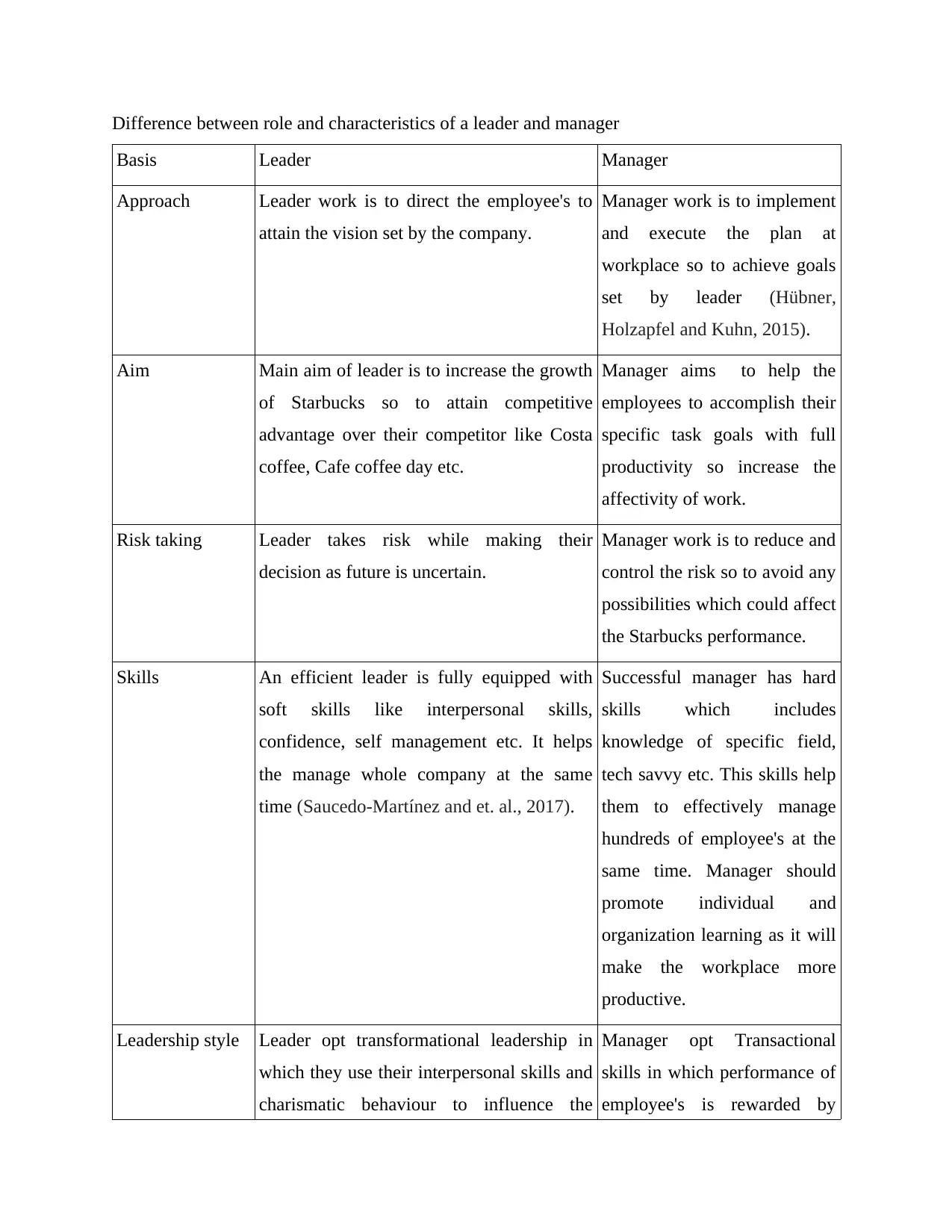
Difference between role and characteristics of a leader and manager
Basis Leader Manager
Approach Leader work is to direct the employee's to
attain the vision set by the company.
Manager work is to implement
and execute the plan at
workplace so to achieve goals
set by leader (Hübner,
Holzapfel and Kuhn, 2015).
Aim Main aim of leader is to increase the growth
of Starbucks so to attain competitive
advantage over their competitor like Costa
coffee, Cafe coffee day etc.
Manager aims to help the
employees to accomplish their
specific task goals with full
productivity so increase the
affectivity of work.
Risk taking Leader takes risk while making their
decision as future is uncertain.
Manager work is to reduce and
control the risk so to avoid any
possibilities which could affect
the Starbucks performance.
Skills An efficient leader is fully equipped with
soft skills like interpersonal skills,
confidence, self management etc. It helps
the manage whole company at the same
time (Saucedo-Martínez and et. al., 2017).
Successful manager has hard
skills which includes
knowledge of specific field,
tech savvy etc. This skills help
them to effectively manage
hundreds of employee's at the
same time. Manager should
promote individual and
organization learning as it will
make the workplace more
productive.
Leadership style Leader opt transformational leadership in
which they use their interpersonal skills and
charismatic behaviour to influence the
Manager opt Transactional
skills in which performance of
employee's is rewarded by
Basis Leader Manager
Approach Leader work is to direct the employee's to
attain the vision set by the company.
Manager work is to implement
and execute the plan at
workplace so to achieve goals
set by leader (Hübner,
Holzapfel and Kuhn, 2015).
Aim Main aim of leader is to increase the growth
of Starbucks so to attain competitive
advantage over their competitor like Costa
coffee, Cafe coffee day etc.
Manager aims to help the
employees to accomplish their
specific task goals with full
productivity so increase the
affectivity of work.
Risk taking Leader takes risk while making their
decision as future is uncertain.
Manager work is to reduce and
control the risk so to avoid any
possibilities which could affect
the Starbucks performance.
Skills An efficient leader is fully equipped with
soft skills like interpersonal skills,
confidence, self management etc. It helps
the manage whole company at the same
time (Saucedo-Martínez and et. al., 2017).
Successful manager has hard
skills which includes
knowledge of specific field,
tech savvy etc. This skills help
them to effectively manage
hundreds of employee's at the
same time. Manager should
promote individual and
organization learning as it will
make the workplace more
productive.
Leadership style Leader opt transformational leadership in
which they use their interpersonal skills and
charismatic behaviour to influence the
Manager opt Transactional
skills in which performance of
employee's is rewarded by
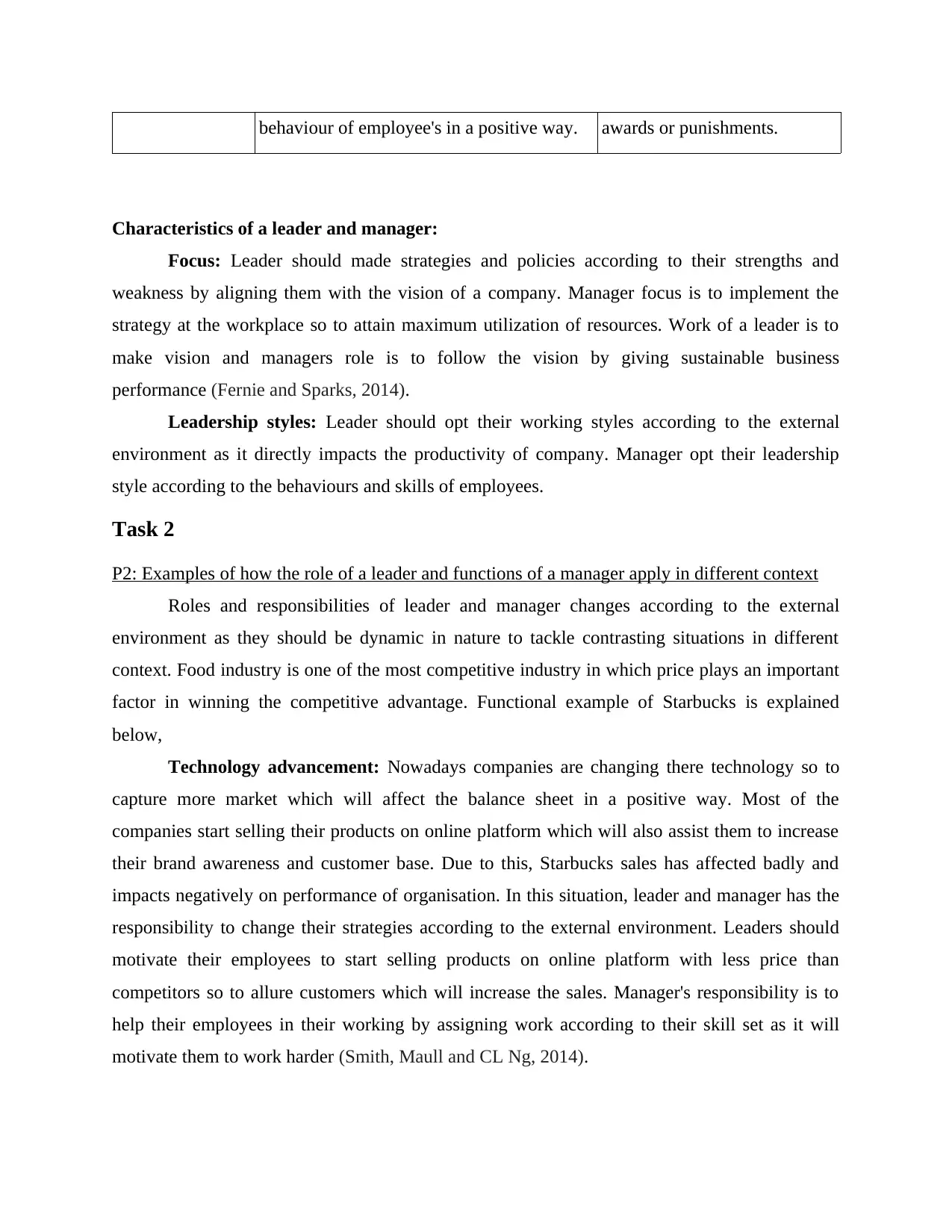
behaviour of employee's in a positive way. awards or punishments.
Characteristics of a leader and manager:
Focus: Leader should made strategies and policies according to their strengths and
weakness by aligning them with the vision of a company. Manager focus is to implement the
strategy at the workplace so to attain maximum utilization of resources. Work of a leader is to
make vision and managers role is to follow the vision by giving sustainable business
performance (Fernie and Sparks, 2014).
Leadership styles: Leader should opt their working styles according to the external
environment as it directly impacts the productivity of company. Manager opt their leadership
style according to the behaviours and skills of employees.
Task 2
P2: Examples of how the role of a leader and functions of a manager apply in different context
Roles and responsibilities of leader and manager changes according to the external
environment as they should be dynamic in nature to tackle contrasting situations in different
context. Food industry is one of the most competitive industry in which price plays an important
factor in winning the competitive advantage. Functional example of Starbucks is explained
below,
Technology advancement: Nowadays companies are changing there technology so to
capture more market which will affect the balance sheet in a positive way. Most of the
companies start selling their products on online platform which will also assist them to increase
their brand awareness and customer base. Due to this, Starbucks sales has affected badly and
impacts negatively on performance of organisation. In this situation, leader and manager has the
responsibility to change their strategies according to the external environment. Leaders should
motivate their employees to start selling products on online platform with less price than
competitors so to allure customers which will increase the sales. Manager's responsibility is to
help their employees in their working by assigning work according to their skill set as it will
motivate them to work harder (Smith, Maull and CL Ng, 2014).
Characteristics of a leader and manager:
Focus: Leader should made strategies and policies according to their strengths and
weakness by aligning them with the vision of a company. Manager focus is to implement the
strategy at the workplace so to attain maximum utilization of resources. Work of a leader is to
make vision and managers role is to follow the vision by giving sustainable business
performance (Fernie and Sparks, 2014).
Leadership styles: Leader should opt their working styles according to the external
environment as it directly impacts the productivity of company. Manager opt their leadership
style according to the behaviours and skills of employees.
Task 2
P2: Examples of how the role of a leader and functions of a manager apply in different context
Roles and responsibilities of leader and manager changes according to the external
environment as they should be dynamic in nature to tackle contrasting situations in different
context. Food industry is one of the most competitive industry in which price plays an important
factor in winning the competitive advantage. Functional example of Starbucks is explained
below,
Technology advancement: Nowadays companies are changing there technology so to
capture more market which will affect the balance sheet in a positive way. Most of the
companies start selling their products on online platform which will also assist them to increase
their brand awareness and customer base. Due to this, Starbucks sales has affected badly and
impacts negatively on performance of organisation. In this situation, leader and manager has the
responsibility to change their strategies according to the external environment. Leaders should
motivate their employees to start selling products on online platform with less price than
competitors so to allure customers which will increase the sales. Manager's responsibility is to
help their employees in their working by assigning work according to their skill set as it will
motivate them to work harder (Smith, Maull and CL Ng, 2014).
⊘ This is a preview!⊘
Do you want full access?
Subscribe today to unlock all pages.

Trusted by 1+ million students worldwide
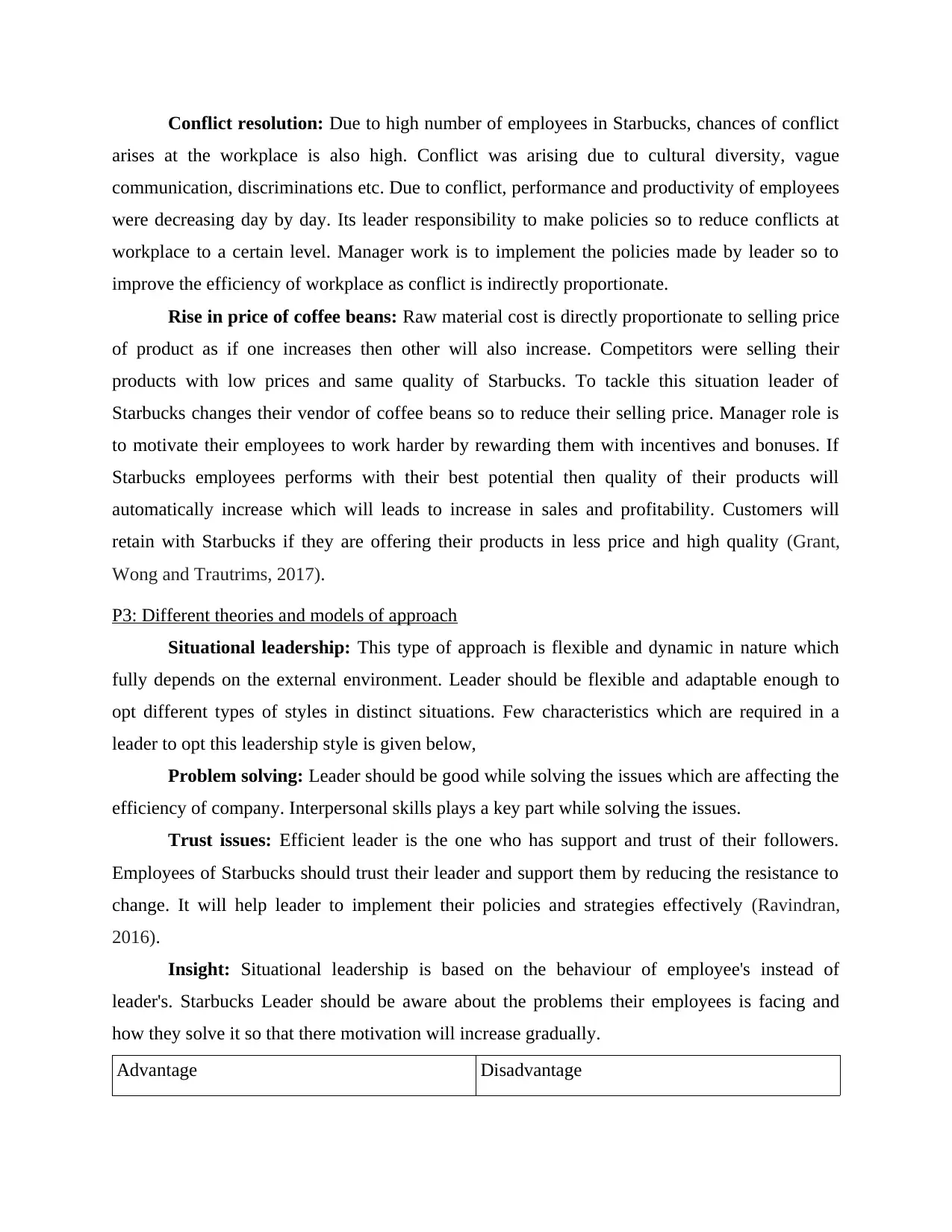
Conflict resolution: Due to high number of employees in Starbucks, chances of conflict
arises at the workplace is also high. Conflict was arising due to cultural diversity, vague
communication, discriminations etc. Due to conflict, performance and productivity of employees
were decreasing day by day. Its leader responsibility to make policies so to reduce conflicts at
workplace to a certain level. Manager work is to implement the policies made by leader so to
improve the efficiency of workplace as conflict is indirectly proportionate.
Rise in price of coffee beans: Raw material cost is directly proportionate to selling price
of product as if one increases then other will also increase. Competitors were selling their
products with low prices and same quality of Starbucks. To tackle this situation leader of
Starbucks changes their vendor of coffee beans so to reduce their selling price. Manager role is
to motivate their employees to work harder by rewarding them with incentives and bonuses. If
Starbucks employees performs with their best potential then quality of their products will
automatically increase which will leads to increase in sales and profitability. Customers will
retain with Starbucks if they are offering their products in less price and high quality (Grant,
Wong and Trautrims, 2017).
P3: Different theories and models of approach
Situational leadership: This type of approach is flexible and dynamic in nature which
fully depends on the external environment. Leader should be flexible and adaptable enough to
opt different types of styles in distinct situations. Few characteristics which are required in a
leader to opt this leadership style is given below,
Problem solving: Leader should be good while solving the issues which are affecting the
efficiency of company. Interpersonal skills plays a key part while solving the issues.
Trust issues: Efficient leader is the one who has support and trust of their followers.
Employees of Starbucks should trust their leader and support them by reducing the resistance to
change. It will help leader to implement their policies and strategies effectively (Ravindran,
2016).
Insight: Situational leadership is based on the behaviour of employee's instead of
leader's. Starbucks Leader should be aware about the problems their employees is facing and
how they solve it so that there motivation will increase gradually.
Advantage Disadvantage
arises at the workplace is also high. Conflict was arising due to cultural diversity, vague
communication, discriminations etc. Due to conflict, performance and productivity of employees
were decreasing day by day. Its leader responsibility to make policies so to reduce conflicts at
workplace to a certain level. Manager work is to implement the policies made by leader so to
improve the efficiency of workplace as conflict is indirectly proportionate.
Rise in price of coffee beans: Raw material cost is directly proportionate to selling price
of product as if one increases then other will also increase. Competitors were selling their
products with low prices and same quality of Starbucks. To tackle this situation leader of
Starbucks changes their vendor of coffee beans so to reduce their selling price. Manager role is
to motivate their employees to work harder by rewarding them with incentives and bonuses. If
Starbucks employees performs with their best potential then quality of their products will
automatically increase which will leads to increase in sales and profitability. Customers will
retain with Starbucks if they are offering their products in less price and high quality (Grant,
Wong and Trautrims, 2017).
P3: Different theories and models of approach
Situational leadership: This type of approach is flexible and dynamic in nature which
fully depends on the external environment. Leader should be flexible and adaptable enough to
opt different types of styles in distinct situations. Few characteristics which are required in a
leader to opt this leadership style is given below,
Problem solving: Leader should be good while solving the issues which are affecting the
efficiency of company. Interpersonal skills plays a key part while solving the issues.
Trust issues: Efficient leader is the one who has support and trust of their followers.
Employees of Starbucks should trust their leader and support them by reducing the resistance to
change. It will help leader to implement their policies and strategies effectively (Ravindran,
2016).
Insight: Situational leadership is based on the behaviour of employee's instead of
leader's. Starbucks Leader should be aware about the problems their employees is facing and
how they solve it so that there motivation will increase gradually.
Advantage Disadvantage
Paraphrase This Document
Need a fresh take? Get an instant paraphrase of this document with our AI Paraphraser
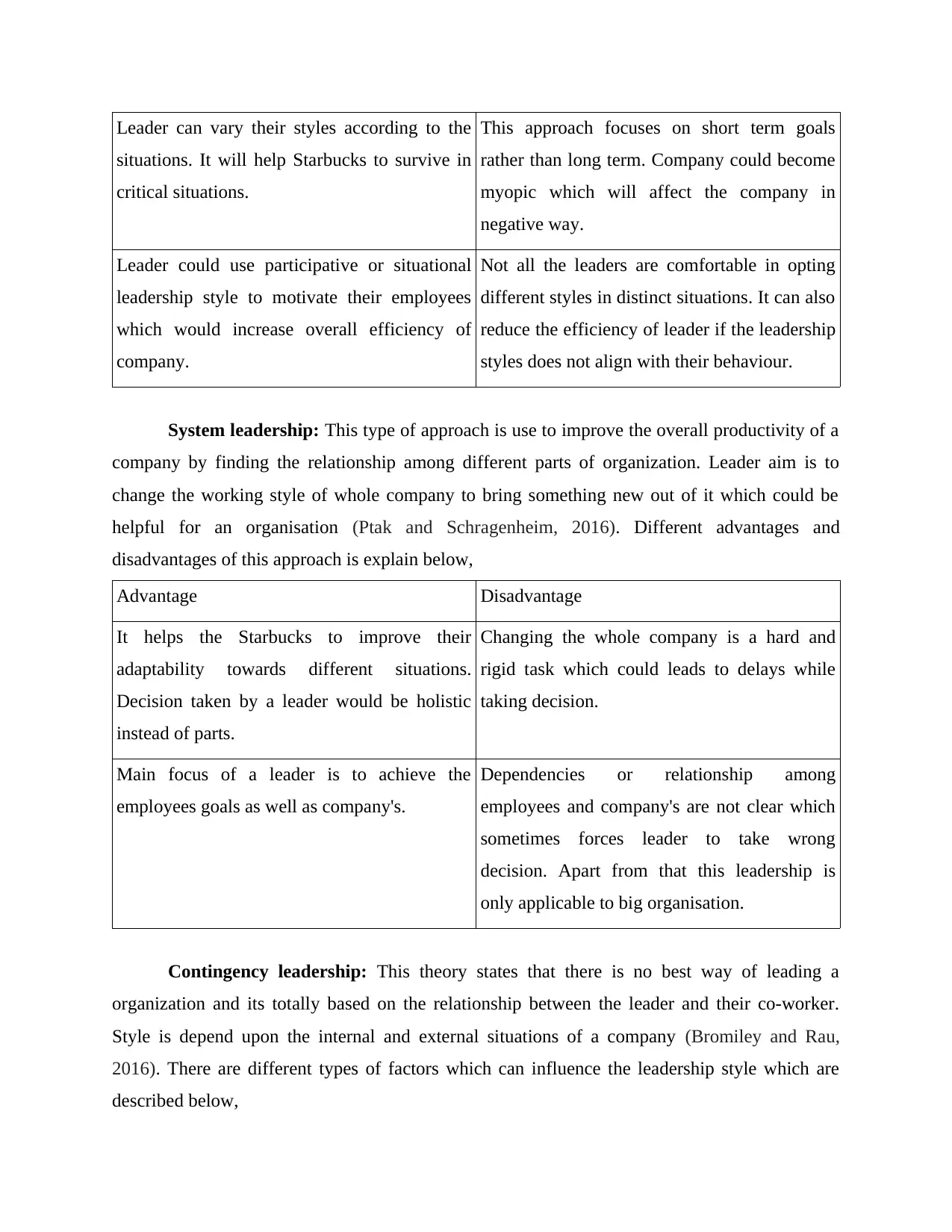
Leader can vary their styles according to the
situations. It will help Starbucks to survive in
critical situations.
This approach focuses on short term goals
rather than long term. Company could become
myopic which will affect the company in
negative way.
Leader could use participative or situational
leadership style to motivate their employees
which would increase overall efficiency of
company.
Not all the leaders are comfortable in opting
different styles in distinct situations. It can also
reduce the efficiency of leader if the leadership
styles does not align with their behaviour.
System leadership: This type of approach is use to improve the overall productivity of a
company by finding the relationship among different parts of organization. Leader aim is to
change the working style of whole company to bring something new out of it which could be
helpful for an organisation (Ptak and Schragenheim, 2016). Different advantages and
disadvantages of this approach is explain below,
Advantage Disadvantage
It helps the Starbucks to improve their
adaptability towards different situations.
Decision taken by a leader would be holistic
instead of parts.
Changing the whole company is a hard and
rigid task which could leads to delays while
taking decision.
Main focus of a leader is to achieve the
employees goals as well as company's.
Dependencies or relationship among
employees and company's are not clear which
sometimes forces leader to take wrong
decision. Apart from that this leadership is
only applicable to big organisation.
Contingency leadership: This theory states that there is no best way of leading a
organization and its totally based on the relationship between the leader and their co-worker.
Style is depend upon the internal and external situations of a company (Bromiley and Rau,
2016). There are different types of factors which can influence the leadership style which are
described below,
situations. It will help Starbucks to survive in
critical situations.
This approach focuses on short term goals
rather than long term. Company could become
myopic which will affect the company in
negative way.
Leader could use participative or situational
leadership style to motivate their employees
which would increase overall efficiency of
company.
Not all the leaders are comfortable in opting
different styles in distinct situations. It can also
reduce the efficiency of leader if the leadership
styles does not align with their behaviour.
System leadership: This type of approach is use to improve the overall productivity of a
company by finding the relationship among different parts of organization. Leader aim is to
change the working style of whole company to bring something new out of it which could be
helpful for an organisation (Ptak and Schragenheim, 2016). Different advantages and
disadvantages of this approach is explain below,
Advantage Disadvantage
It helps the Starbucks to improve their
adaptability towards different situations.
Decision taken by a leader would be holistic
instead of parts.
Changing the whole company is a hard and
rigid task which could leads to delays while
taking decision.
Main focus of a leader is to achieve the
employees goals as well as company's.
Dependencies or relationship among
employees and company's are not clear which
sometimes forces leader to take wrong
decision. Apart from that this leadership is
only applicable to big organisation.
Contingency leadership: This theory states that there is no best way of leading a
organization and its totally based on the relationship between the leader and their co-worker.
Style is depend upon the internal and external situations of a company (Bromiley and Rau,
2016). There are different types of factors which can influence the leadership style which are
described below,
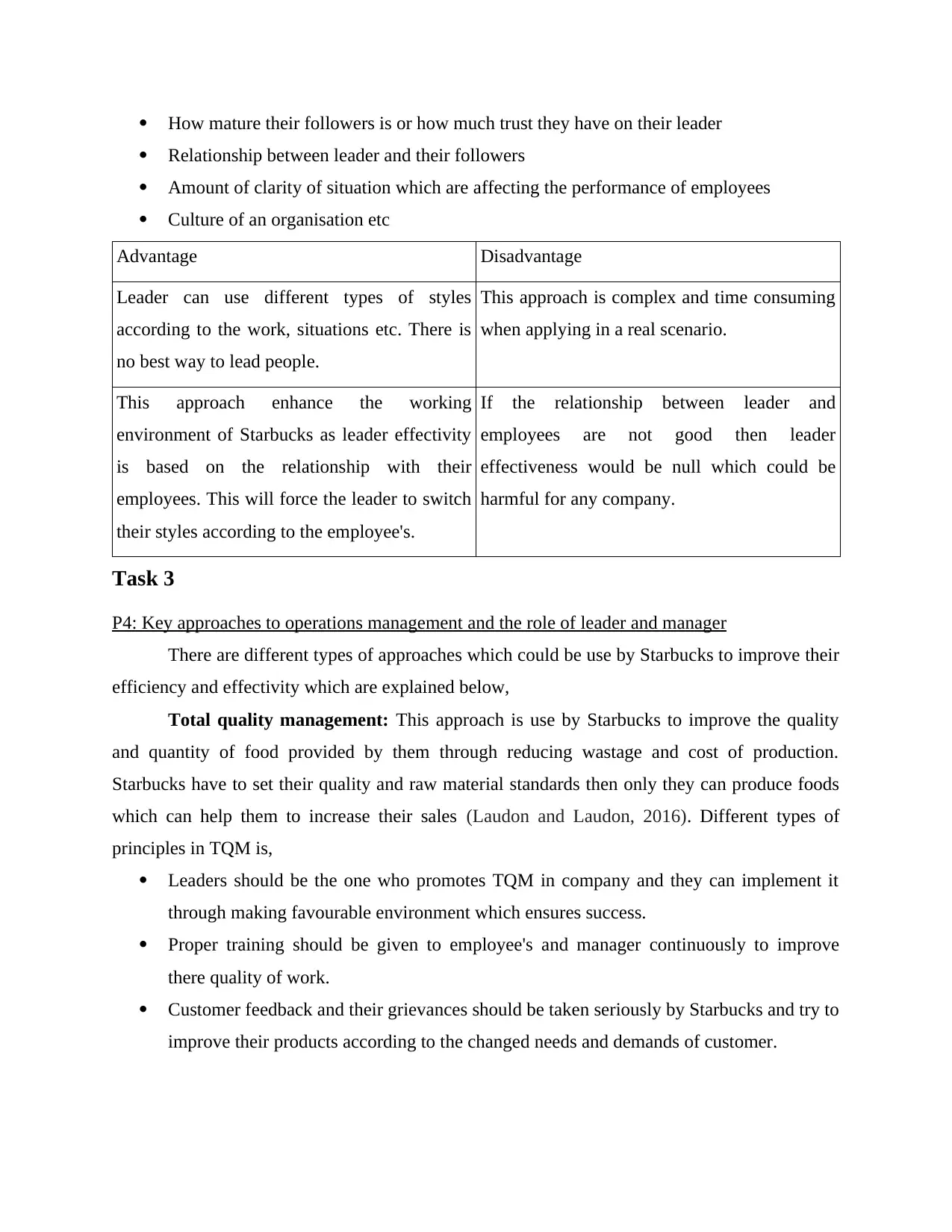
How mature their followers is or how much trust they have on their leader
Relationship between leader and their followers
Amount of clarity of situation which are affecting the performance of employees
Culture of an organisation etc
Advantage Disadvantage
Leader can use different types of styles
according to the work, situations etc. There is
no best way to lead people.
This approach is complex and time consuming
when applying in a real scenario.
This approach enhance the working
environment of Starbucks as leader effectivity
is based on the relationship with their
employees. This will force the leader to switch
their styles according to the employee's.
If the relationship between leader and
employees are not good then leader
effectiveness would be null which could be
harmful for any company.
Task 3
P4: Key approaches to operations management and the role of leader and manager
There are different types of approaches which could be use by Starbucks to improve their
efficiency and effectivity which are explained below,
Total quality management: This approach is use by Starbucks to improve the quality
and quantity of food provided by them through reducing wastage and cost of production.
Starbucks have to set their quality and raw material standards then only they can produce foods
which can help them to increase their sales (Laudon and Laudon, 2016). Different types of
principles in TQM is,
Leaders should be the one who promotes TQM in company and they can implement it
through making favourable environment which ensures success.
Proper training should be given to employee's and manager continuously to improve
there quality of work.
Customer feedback and their grievances should be taken seriously by Starbucks and try to
improve their products according to the changed needs and demands of customer.
Relationship between leader and their followers
Amount of clarity of situation which are affecting the performance of employees
Culture of an organisation etc
Advantage Disadvantage
Leader can use different types of styles
according to the work, situations etc. There is
no best way to lead people.
This approach is complex and time consuming
when applying in a real scenario.
This approach enhance the working
environment of Starbucks as leader effectivity
is based on the relationship with their
employees. This will force the leader to switch
their styles according to the employee's.
If the relationship between leader and
employees are not good then leader
effectiveness would be null which could be
harmful for any company.
Task 3
P4: Key approaches to operations management and the role of leader and manager
There are different types of approaches which could be use by Starbucks to improve their
efficiency and effectivity which are explained below,
Total quality management: This approach is use by Starbucks to improve the quality
and quantity of food provided by them through reducing wastage and cost of production.
Starbucks have to set their quality and raw material standards then only they can produce foods
which can help them to increase their sales (Laudon and Laudon, 2016). Different types of
principles in TQM is,
Leaders should be the one who promotes TQM in company and they can implement it
through making favourable environment which ensures success.
Proper training should be given to employee's and manager continuously to improve
there quality of work.
Customer feedback and their grievances should be taken seriously by Starbucks and try to
improve their products according to the changed needs and demands of customer.
⊘ This is a preview!⊘
Do you want full access?
Subscribe today to unlock all pages.

Trusted by 1+ million students worldwide
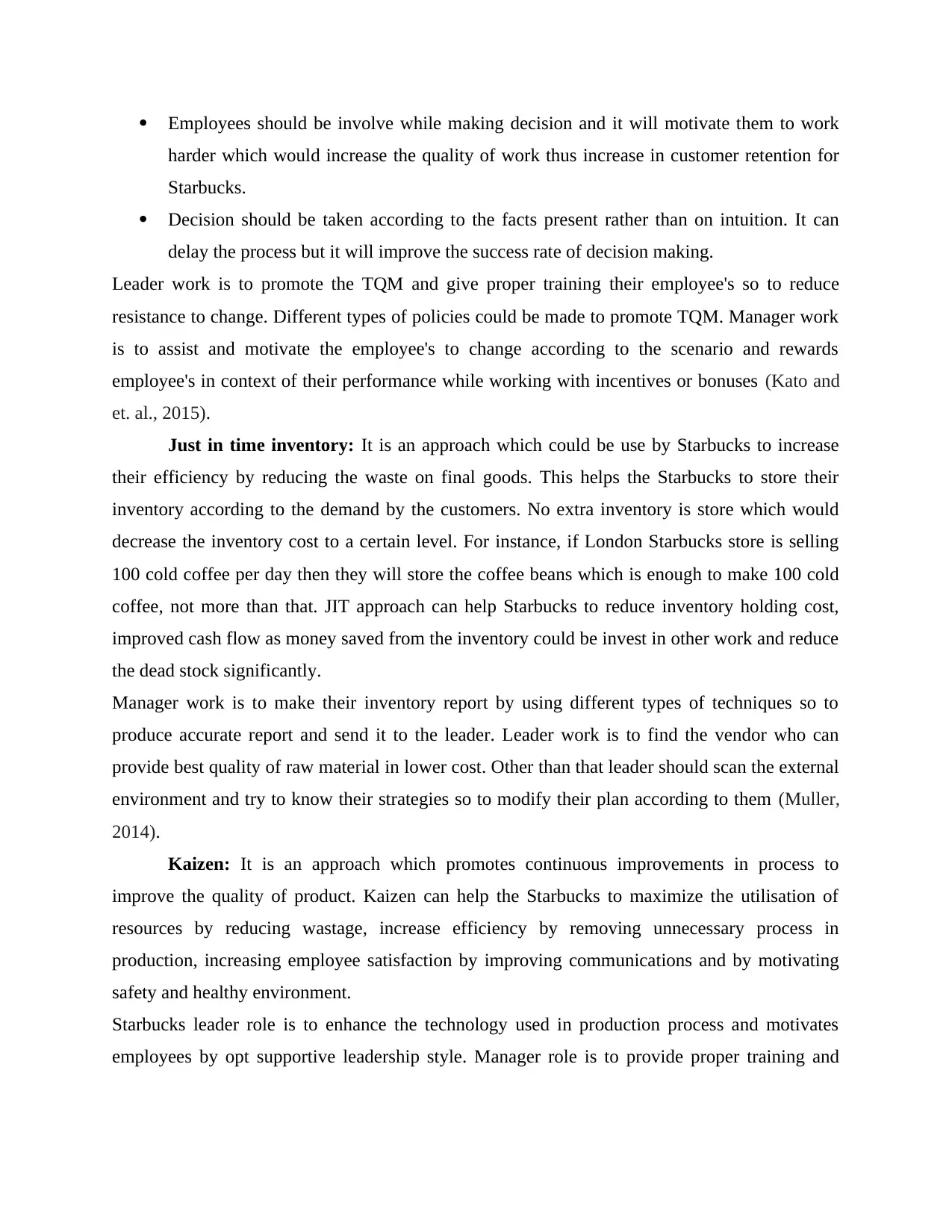
Employees should be involve while making decision and it will motivate them to work
harder which would increase the quality of work thus increase in customer retention for
Starbucks.
Decision should be taken according to the facts present rather than on intuition. It can
delay the process but it will improve the success rate of decision making.
Leader work is to promote the TQM and give proper training their employee's so to reduce
resistance to change. Different types of policies could be made to promote TQM. Manager work
is to assist and motivate the employee's to change according to the scenario and rewards
employee's in context of their performance while working with incentives or bonuses (Kato and
et. al., 2015).
Just in time inventory: It is an approach which could be use by Starbucks to increase
their efficiency by reducing the waste on final goods. This helps the Starbucks to store their
inventory according to the demand by the customers. No extra inventory is store which would
decrease the inventory cost to a certain level. For instance, if London Starbucks store is selling
100 cold coffee per day then they will store the coffee beans which is enough to make 100 cold
coffee, not more than that. JIT approach can help Starbucks to reduce inventory holding cost,
improved cash flow as money saved from the inventory could be invest in other work and reduce
the dead stock significantly.
Manager work is to make their inventory report by using different types of techniques so to
produce accurate report and send it to the leader. Leader work is to find the vendor who can
provide best quality of raw material in lower cost. Other than that leader should scan the external
environment and try to know their strategies so to modify their plan according to them (Muller,
2014).
Kaizen: It is an approach which promotes continuous improvements in process to
improve the quality of product. Kaizen can help the Starbucks to maximize the utilisation of
resources by reducing wastage, increase efficiency by removing unnecessary process in
production, increasing employee satisfaction by improving communications and by motivating
safety and healthy environment.
Starbucks leader role is to enhance the technology used in production process and motivates
employees by opt supportive leadership style. Manager role is to provide proper training and
harder which would increase the quality of work thus increase in customer retention for
Starbucks.
Decision should be taken according to the facts present rather than on intuition. It can
delay the process but it will improve the success rate of decision making.
Leader work is to promote the TQM and give proper training their employee's so to reduce
resistance to change. Different types of policies could be made to promote TQM. Manager work
is to assist and motivate the employee's to change according to the scenario and rewards
employee's in context of their performance while working with incentives or bonuses (Kato and
et. al., 2015).
Just in time inventory: It is an approach which could be use by Starbucks to increase
their efficiency by reducing the waste on final goods. This helps the Starbucks to store their
inventory according to the demand by the customers. No extra inventory is store which would
decrease the inventory cost to a certain level. For instance, if London Starbucks store is selling
100 cold coffee per day then they will store the coffee beans which is enough to make 100 cold
coffee, not more than that. JIT approach can help Starbucks to reduce inventory holding cost,
improved cash flow as money saved from the inventory could be invest in other work and reduce
the dead stock significantly.
Manager work is to make their inventory report by using different types of techniques so to
produce accurate report and send it to the leader. Leader work is to find the vendor who can
provide best quality of raw material in lower cost. Other than that leader should scan the external
environment and try to know their strategies so to modify their plan according to them (Muller,
2014).
Kaizen: It is an approach which promotes continuous improvements in process to
improve the quality of product. Kaizen can help the Starbucks to maximize the utilisation of
resources by reducing wastage, increase efficiency by removing unnecessary process in
production, increasing employee satisfaction by improving communications and by motivating
safety and healthy environment.
Starbucks leader role is to enhance the technology used in production process and motivates
employees by opt supportive leadership style. Manager role is to provide proper training and
Paraphrase This Document
Need a fresh take? Get an instant paraphrase of this document with our AI Paraphraser
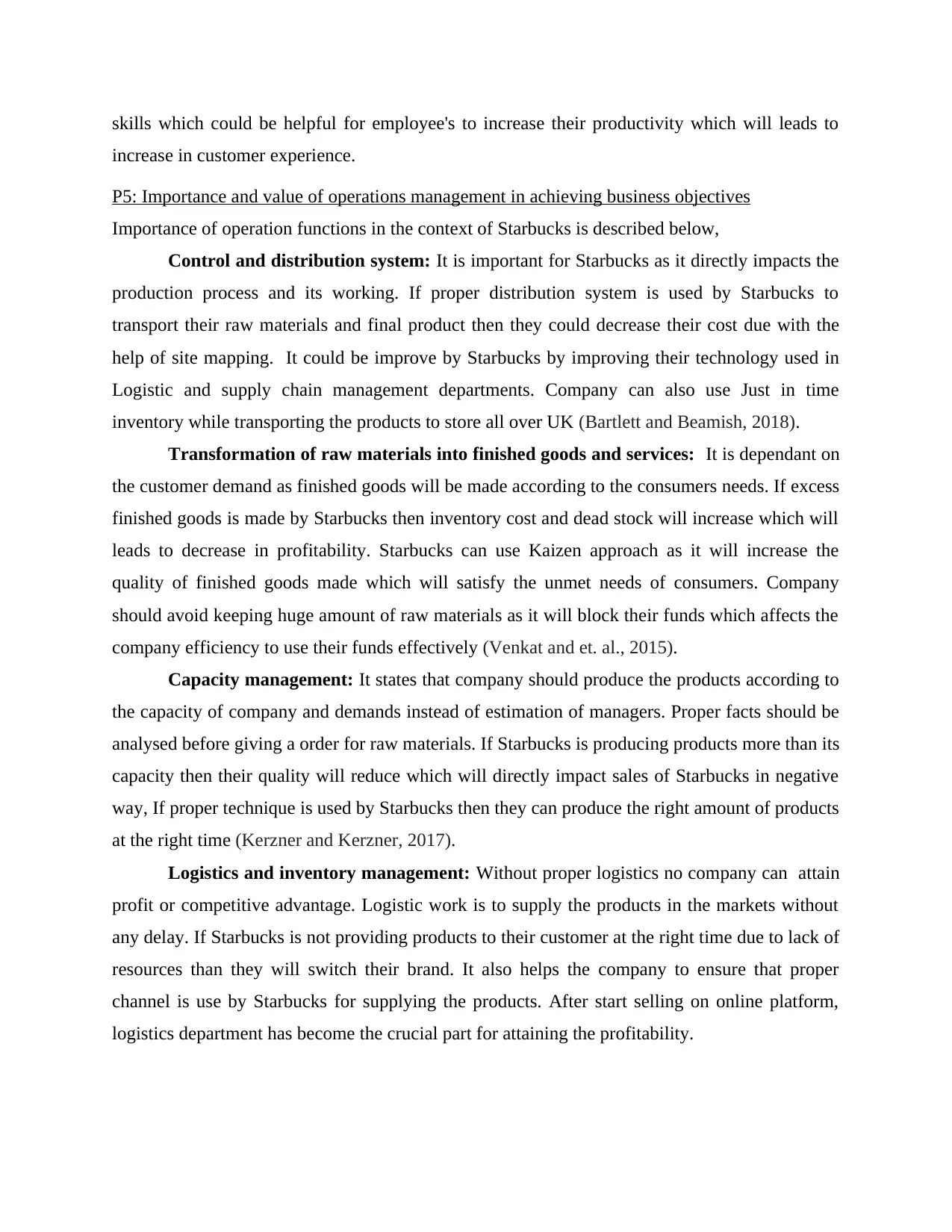
skills which could be helpful for employee's to increase their productivity which will leads to
increase in customer experience.
P5: Importance and value of operations management in achieving business objectives
Importance of operation functions in the context of Starbucks is described below,
Control and distribution system: It is important for Starbucks as it directly impacts the
production process and its working. If proper distribution system is used by Starbucks to
transport their raw materials and final product then they could decrease their cost due with the
help of site mapping. It could be improve by Starbucks by improving their technology used in
Logistic and supply chain management departments. Company can also use Just in time
inventory while transporting the products to store all over UK (Bartlett and Beamish, 2018).
Transformation of raw materials into finished goods and services: It is dependant on
the customer demand as finished goods will be made according to the consumers needs. If excess
finished goods is made by Starbucks then inventory cost and dead stock will increase which will
leads to decrease in profitability. Starbucks can use Kaizen approach as it will increase the
quality of finished goods made which will satisfy the unmet needs of consumers. Company
should avoid keeping huge amount of raw materials as it will block their funds which affects the
company efficiency to use their funds effectively (Venkat and et. al., 2015).
Capacity management: It states that company should produce the products according to
the capacity of company and demands instead of estimation of managers. Proper facts should be
analysed before giving a order for raw materials. If Starbucks is producing products more than its
capacity then their quality will reduce which will directly impact sales of Starbucks in negative
way, If proper technique is used by Starbucks then they can produce the right amount of products
at the right time (Kerzner and Kerzner, 2017).
Logistics and inventory management: Without proper logistics no company can attain
profit or competitive advantage. Logistic work is to supply the products in the markets without
any delay. If Starbucks is not providing products to their customer at the right time due to lack of
resources than they will switch their brand. It also helps the company to ensure that proper
channel is use by Starbucks for supplying the products. After start selling on online platform,
logistics department has become the crucial part for attaining the profitability.
increase in customer experience.
P5: Importance and value of operations management in achieving business objectives
Importance of operation functions in the context of Starbucks is described below,
Control and distribution system: It is important for Starbucks as it directly impacts the
production process and its working. If proper distribution system is used by Starbucks to
transport their raw materials and final product then they could decrease their cost due with the
help of site mapping. It could be improve by Starbucks by improving their technology used in
Logistic and supply chain management departments. Company can also use Just in time
inventory while transporting the products to store all over UK (Bartlett and Beamish, 2018).
Transformation of raw materials into finished goods and services: It is dependant on
the customer demand as finished goods will be made according to the consumers needs. If excess
finished goods is made by Starbucks then inventory cost and dead stock will increase which will
leads to decrease in profitability. Starbucks can use Kaizen approach as it will increase the
quality of finished goods made which will satisfy the unmet needs of consumers. Company
should avoid keeping huge amount of raw materials as it will block their funds which affects the
company efficiency to use their funds effectively (Venkat and et. al., 2015).
Capacity management: It states that company should produce the products according to
the capacity of company and demands instead of estimation of managers. Proper facts should be
analysed before giving a order for raw materials. If Starbucks is producing products more than its
capacity then their quality will reduce which will directly impact sales of Starbucks in negative
way, If proper technique is used by Starbucks then they can produce the right amount of products
at the right time (Kerzner and Kerzner, 2017).
Logistics and inventory management: Without proper logistics no company can attain
profit or competitive advantage. Logistic work is to supply the products in the markets without
any delay. If Starbucks is not providing products to their customer at the right time due to lack of
resources than they will switch their brand. It also helps the company to ensure that proper
channel is use by Starbucks for supplying the products. After start selling on online platform,
logistics department has become the crucial part for attaining the profitability.
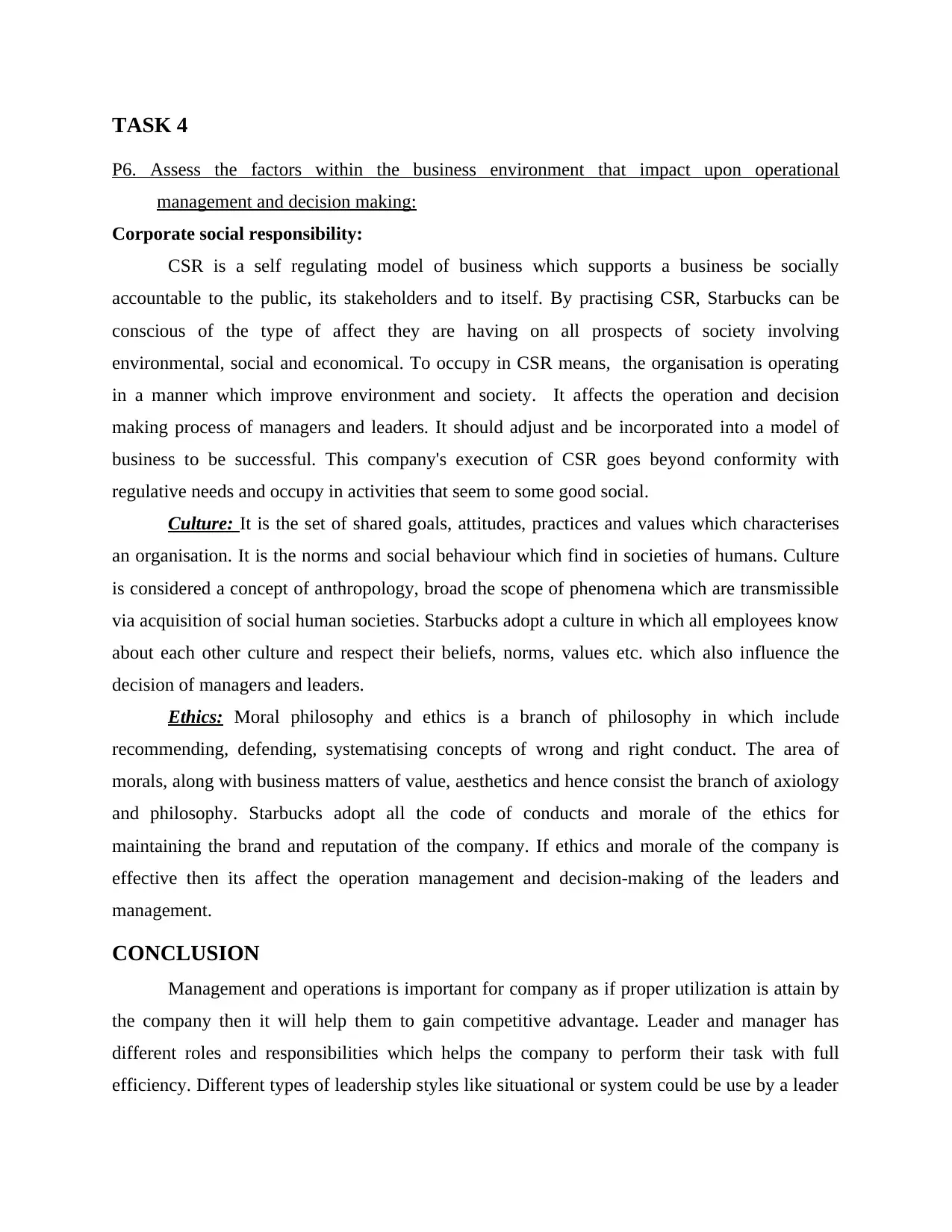
TASK 4
P6. Assess the factors within the business environment that impact upon operational
management and decision making:
Corporate social responsibility:
CSR is a self regulating model of business which supports a business be socially
accountable to the public, its stakeholders and to itself. By practising CSR, Starbucks can be
conscious of the type of affect they are having on all prospects of society involving
environmental, social and economical. To occupy in CSR means, the organisation is operating
in a manner which improve environment and society. It affects the operation and decision
making process of managers and leaders. It should adjust and be incorporated into a model of
business to be successful. This company's execution of CSR goes beyond conformity with
regulative needs and occupy in activities that seem to some good social.
Culture: It is the set of shared goals, attitudes, practices and values which characterises
an organisation. It is the norms and social behaviour which find in societies of humans. Culture
is considered a concept of anthropology, broad the scope of phenomena which are transmissible
via acquisition of social human societies. Starbucks adopt a culture in which all employees know
about each other culture and respect their beliefs, norms, values etc. which also influence the
decision of managers and leaders.
Ethics: Moral philosophy and ethics is a branch of philosophy in which include
recommending, defending, systematising concepts of wrong and right conduct. The area of
morals, along with business matters of value, aesthetics and hence consist the branch of axiology
and philosophy. Starbucks adopt all the code of conducts and morale of the ethics for
maintaining the brand and reputation of the company. If ethics and morale of the company is
effective then its affect the operation management and decision-making of the leaders and
management.
CONCLUSION
Management and operations is important for company as if proper utilization is attain by
the company then it will help them to gain competitive advantage. Leader and manager has
different roles and responsibilities which helps the company to perform their task with full
efficiency. Different types of leadership styles like situational or system could be use by a leader
P6. Assess the factors within the business environment that impact upon operational
management and decision making:
Corporate social responsibility:
CSR is a self regulating model of business which supports a business be socially
accountable to the public, its stakeholders and to itself. By practising CSR, Starbucks can be
conscious of the type of affect they are having on all prospects of society involving
environmental, social and economical. To occupy in CSR means, the organisation is operating
in a manner which improve environment and society. It affects the operation and decision
making process of managers and leaders. It should adjust and be incorporated into a model of
business to be successful. This company's execution of CSR goes beyond conformity with
regulative needs and occupy in activities that seem to some good social.
Culture: It is the set of shared goals, attitudes, practices and values which characterises
an organisation. It is the norms and social behaviour which find in societies of humans. Culture
is considered a concept of anthropology, broad the scope of phenomena which are transmissible
via acquisition of social human societies. Starbucks adopt a culture in which all employees know
about each other culture and respect their beliefs, norms, values etc. which also influence the
decision of managers and leaders.
Ethics: Moral philosophy and ethics is a branch of philosophy in which include
recommending, defending, systematising concepts of wrong and right conduct. The area of
morals, along with business matters of value, aesthetics and hence consist the branch of axiology
and philosophy. Starbucks adopt all the code of conducts and morale of the ethics for
maintaining the brand and reputation of the company. If ethics and morale of the company is
effective then its affect the operation management and decision-making of the leaders and
management.
CONCLUSION
Management and operations is important for company as if proper utilization is attain by
the company then it will help them to gain competitive advantage. Leader and manager has
different roles and responsibilities which helps the company to perform their task with full
efficiency. Different types of leadership styles like situational or system could be use by a leader
⊘ This is a preview!⊘
Do you want full access?
Subscribe today to unlock all pages.

Trusted by 1+ million students worldwide
1 out of 14
Related Documents
Your All-in-One AI-Powered Toolkit for Academic Success.
+13062052269
info@desklib.com
Available 24*7 on WhatsApp / Email
![[object Object]](/_next/static/media/star-bottom.7253800d.svg)
Unlock your academic potential
Copyright © 2020–2025 A2Z Services. All Rights Reserved. Developed and managed by ZUCOL.





